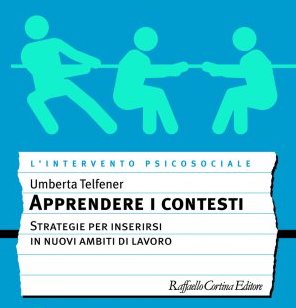Rational for this book:
The world has changed. Young professionals nowadays need to be well trained, highly focused, and they have to be clear about how to organize themselves and their work. They need to know limits and scope of what they can offer and what to expect. This requires not only a greater awareness of one’s own abilities, but also of the work contexts one joins. Young professionals have to find and establish their own roles and positions, working respectfully in partnership with employers, clients and different agencies. For this to be successful, they cannot rely on improvisation, but need to acquire specific reflective skills.
This book offers pragmatic know-how as well as a conceptual framework for entering a new work setting, for being able to integrate whilst at the same time finding appropriate space for initiatives and building one’s own professional career.
Mastering/learning contexts is a Batesonian construct (1979) (“Learning life context has to be discussed as the relationship among two creatures …”). The book pursues the idea that entering into any “new” context is a kind of clinical encounter and event, both complex and demanding. This is the case for professionals from very different disciplines, be that psychology, psychiatry, family therapy, nursing, education and other allied professions in the mental health field. This is also true for those starting work in hospitals, schools, prisons, training settings, child guidance settings and in private practice.
Synopsis:
This book, originally published in Italy by Cortina Editore (2011), takes into consideration mental health work in public social contexts and deals with the theoretical and pragmatic frameworks required to join and work at one’s best, following the mandate. Using systemic concepts, it reflects on how to introduce oneself in a new place of work, how to find one’s position and create working relationships with colleagues who may have been working together for a long time and who share a common working model.
The book argues that the same concepts apply to all members of the helping professions, provided that context is embraced. Systemic concepts are put forward and shared via practical examples, from the disciplines of psychology, psychiatry, social work, education, nursing, teaching and management.
The book addresses all professionals working in socio-health settings and other contexts connected with welfare, whatever their position. It is meant to help them to learn about the power of systems and organizations and how these influence those who are part of them; if they become aware of the importance of taking a ‘break’ and reflect on what is going on, it will equip them to ‘manage’ systems and themselves so not to risk to become iatrogenic.
The book offers pathways to:
• Employing ‘observing lenses’ and the ‘not knowing’ stance of the clinician
• Analyzing working contexts (e.g. who has made the request for help, what are the different positions of employees and clients)
• Undertaking a thorough analysis of the request for help, as well as redefining the needs of the clients and the larger ‘system’, in order to make a sharp proposal and a respectful project
• Building operability and projects
• Considering the possibility of undesired outcomes and the risk of colluding with the system
This approach enhances the possibilities of reflecting on the different scenarios and choices which professionals can, or may have to make. Specific clinical pathways are proposed so as to help professionals integrate into a working group, connecting with others, increasing their confidence, and learning to avoid possible communicational traps and undesired outcomes. In this book, each basic systemic construct is presented both theoretically and through more than one clinical example.
Book Scheme (I have made some adjustments in the subdivision of chapters in order to make the book more friendly for an Anglo Saxon public):
INDEX
Forward (IX-XIII)
Who wrote this book, for whom it is written, what is the content
Introduction (XIII-XXV)
PART 1
Chapter 1: THE WAY WE OBSERVE (3-31)
Grids to observe
Epistemology as a theory for the construction of knowledge
The systemic paradigm as a tool for complexity
Language, communication as builders of our reality
Different stances toward knowing
Inevitable prejudices
Cultural aspects
Triadic interpretation of interactions
Levels of observation in relational encounters
The scope of this book
What we have proposed in this chapter
Chapter 2: IDENTIFYING A SYSTEM (33-65)
The individual as part of a larger context
Different models to read organizations
The systemic model, some presuppositions in order to interpret organizations
Climate, organization and culture
The paradox of the constitutive nucleus
Time as an evolving process
When in an organization there is a problem
How to analyze an organization
Proposing a grid to read organizations
What we have proposed in this chapter
Chapter 3: OBSERVING SYSTEMS (67-108)
Entering into a system
Why professionals need the institution
The institution needs us, as well
The quest as a connecting element
Analyzing the quest
The quest as part of a game
Redefining the quest
The psychotherapeutic quest
Different positioning of the mental health professional
Making a system emerge
The positioning and where to place oneself
What we have proposed in this chapter
Chapter 4: REFLECTIONS ON ONE’S WORK (109-126)
Basic competences for professionals
Listening
Relational ability
Asking questions
Comprehending feedback
Stimulating curiosity
Analyzing needs and resources
Hypothesizing
Introducing difference
Making a plan, building objectives
Respecting and understanding the complexity of the system
The use of self
Considering time and process
Chapter 5: OPERATIONS TO ENTER A SYSTEM (126-145)
Operation to enter into a “new” system
Observing and analyzing the context
Who is the employer, who the client
The agenda
The referral
Inviting the participants
Defining the setting
Engaging in the relationship
The contract
Designing the intervention
What we have proposed in this chapter
Chapter 6: WORKING WITH OTHERS, BUILDING A PLURIVERSE (147-184)
Connecting patterns
Constructing a team mind
Working as a team
Networking
The importance of supervision
Relational games which have to be spotted
Pseudo-mutuality
Schizogenesis
Contextual sliding
Triangulation
Disqualification
Perverse coalition
Paradoxical communication
The double bind
Scapegoating
Rigid symmetry and complementarities
Parentifying the structure
What we have proposed in this chapter
Chapter 7: THE PROFESSIONAL’S RESPONSIBILITIES (185-202)
The mental health professionals responsibilities
Proposing second order operations
Differentiating between deferring solutions and taking charge
Building oneself as a variable
Redefining the quest
Strategizing in order to perturb
Analyze the relationship between costs and benefits
Chapter 8: UNEXPECTED EVENTS, UNDESIRED OUTCOMES (202-220)
Possible traps
Resonance
Collusion as an adaptive and homeostatic game
Chronification
The risk of iatrogenic risk
Workers’ burnout
What we have proposed in this chapter
PART 2
Chapter 1: EXPERIENCES AS NARRATIVES, Lara Villani (223-270 + 282-284)
(I have eliminated 5 narrations since they deal with typically Italian settings)
A psychologist in the world of the international cooperation, M. Tomassoni, psychologist
Entering into a social cooperative, V. Migliola, psychologist
Entering into a prison, L. Silvestris, psychologist
Diversity is richness, S. Testamigna, professional nurse
Inclusion of a physiotherapist, S. Faenza, physiotherapist
Consultancy to a small town mayor , L. Villani, psychologist
Being a volunteer in an oncology unit, S. Passalacqua, psychologist
Entering into a psycho-nutritional outpatient service, M. Guadagno, psychologist
Reading emergency: working with a community wounded by earthquake, G. Spalla, psychologist
To train oneself to network communication, E. Baldini, educator
Continual restructuring, working abroad with a International organization, F. Dazzi, psychologist
The business place: a case of a consultant psychologist in a consultancy agency, L. Gallerano, psychologist
The experience in a disability service, F. Di Curzio, social worker
A foster home for adolescents, F. Banti, psychologist
The work of a social worker in a women’ shelter, E. Pandolfo, social worker
Entering a school, Lara Villani, psychologist
Chapter 2: OPERATIVITY AND LAWS, A FOUNDAMENTAL RELATIONSHIP, Lara Villani (287-288)
(This becomes just a small chapter, two pages long. It’s useless to translate the Italian laws of the different professions and contexts.)
Chapter 3: A GLOSSARY FOR MENTAL HEALTH PROFESSIONALS, Lara Villani (we have two choices: or to erase this chapter or to find a professional who adapts the single acronyms to the British context)
EPILOGUE: TO BE OR NOT TO BE, Antonia Palmisano (329-333, 5 pages)
REFERENCES (335-343, 9 pages)
Target market
This book is intended primary for professionals of the mental health field who are in training or have just finished it, since it offers the basic concepts in systemic thinking, wherever they are going to work. It teaches complexity and relational thinking, it allows to connect ideas and not to simplify reality. It is also fundamental for mental health professionals who work or intend to work in public and private settings: the ones who need to present projects in different context and analyze the needs of the environment in order to propose interventions. It will be useful to those who need to respond to a job request and put forward a new proposition. The book assumes that community work and psychotherapy are two sides of the same way of working, and concentrates on the community aspect. Specialized for psychologist and psychiatrist, it addresses all mental health professionals and deals with the work of all kind of different figures, social workers, nurses, educators, management consultant, teachers, doctors …
It is interesting for every setting in which mental health professionals need to enter a new job context.
The book is aimed at people who need to become pragmatic about what to do once they will become operative. In Italy it was adopted by a University course in Psychology Foundations of psychology of the organizations, Prof. Cristina Zucchermaglio and was found very helpful by junior psychologist in private systemic training courses. It is also aimed at senior professionals who want to rehearse their working procedures and want to reflect on their doing.
Competing Books
The book is the result of 15 years of supervision in public and private settings. It collects the clinical thinking every professional needs to do in order to work at her best. To my knowledge there are no present books exactly of this kind.
The following books came to mind even if they have different targets:
– M. P. Nicols, The essentials of family therapy, Pearson/Allyn & Bacon, 2007, which deals with family therapy while Apprendere i contesti proposes a more practical clinical focus not on psychotherapy but more on working in different context with different kinds of clients at a first order level.
– Mara Selvini Palazzoli’s The hidden games of organizations Routledge (1981 in Italy, 1st American edition May 1990),
– Mara Selvini Palazzoli’s The magician without magic (on school interventions, 1976 in Italian, translated in Spanish El Mago sin magia, but not in English) which still has a great success in Italy and Spanish countries and still is considered a “must book” in training.
– Stefano Cirillo’s Il cambiamento nei contesti non terapeutici 1990, (El Cambio En Los Contextos No Terapeuticos – Spanish Edition 1998).
Similar could be books which propose systemic thinking and doing in mental health settings which I am not aware of.
I think this book is necessary in this period in time for its structure which is respectful of the socio-sanitary reform taking place in England. It responds to the needs of young professionals, who could advantage of a systemic frame even if they don’t declare themselves systemic.



